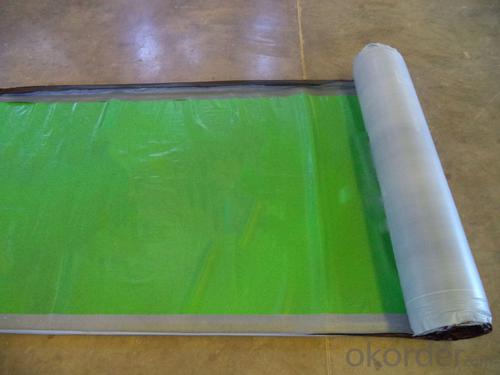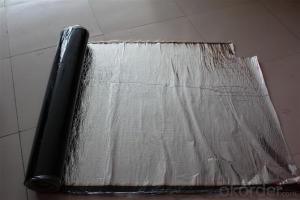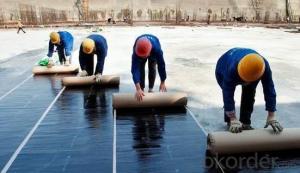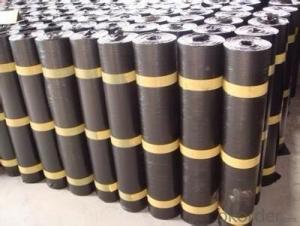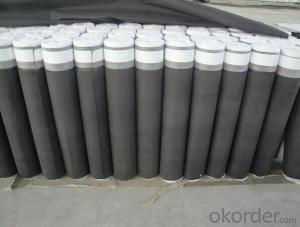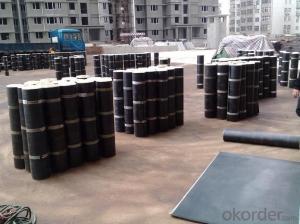Self adhesive bitumen waterproof membrane
- Loading Port:
- Qingdao
- Payment Terms:
- TT OR LC
- Min Order Qty:
- 500 m²
- Supply Capability:
- 1000000 m²/month
OKorder Service Pledge
OKorder Financial Service
You Might Also Like
1. Introduction
Self-adhesive bitumen waterproof membrane is composed of base material, including synthetic
rubber like SBS, good road asphalt and viscosity increaser. The surface is covered by PE film,
aluminum foil film, EVA, HDPE, and the silicon depositing release film is covered on the lower
surface as anti-sticking layer.
2. Specification
1) Thick: 1.2mm, 1.5mm, 2.0mm, 3.0mm, 4.0mm
2) Size: 1m (width)*10m (length) or customized
3) Type: With or without polyester felt
4) Surface: PE film, aluminum foil film, EVA/HDPE, Double-side adhesive PE film
5) Certificate: ISO9001/14001
3. Applications
1) Widely used in the industrial and civil building roofing, underground, pool, tunnel,
wooden and metal roofing.
2) Specially applied in the chemical factory, garment factory, and granary.
3) Especially used in cold places.
4) Tape used for sealing all construction material surfaces.
4. Features
1) Cold-applied construction with no open flame and self-adhesion without bonding agent
make it safe, low- carbon, environmental, and economical.
2) Excellent adhesive performance guarantees the integrity of waterproof layer.
3) Good rubber elasticity, elongation and shear stress
4) Good low-temperature property
- Q: Can a waterproofing membrane be applied on curved surfaces?
- Indeed, curved surfaces can indeed be coated with a waterproofing membrane. In reality, waterproofing membranes are designed to possess flexibility and adaptability, which render them suitable for usage on a variety of shapes and contours, including curved surfaces. These membranes are typically constructed from materials like modified bitumen, polyurethane, or rubber, all of which possess exceptional properties of elongation and flexibility. Thus, they can be easily shaped and stretched to conform to curved surfaces without compromising their waterproofing abilities. Consequently, structures featuring curved components like roofs, balconies, tunnels, and tanks can be effectively waterproofed. However, proper installation techniques and specialized tools may be necessary to ensure appropriate adherence and complete coverage on curved surfaces. Nevertheless, with the appropriate expertise and materials, successful application of waterproofing membranes on curved surfaces can be achieved.
- Q: Can a waterproofing membrane be used for plaza decks?
- Yes, a waterproofing membrane can be used for plaza decks. Plaza decks are typically outdoor spaces that require protection from water infiltration to prevent damage to the underlying structure. Waterproofing membranes are designed to create a barrier that prevents water from seeping into the deck and causing issues such as leaks, deterioration, and structural damage. These membranes are often made of materials such as bitumen, rubber, or polyurethane, which are highly resistant to water penetration. By installing a waterproofing membrane on a plaza deck, it ensures that the deck remains watertight and protects the integrity of the entire structure. Additionally, these membranes can also provide added benefits such as UV resistance, durability, and ease of maintenance, making them an ideal solution for plaza decks.
- Q: Are there any specific building code requirements for using a waterproofing membrane?
- Yes, there are specific building code requirements for using a waterproofing membrane. Building codes vary by jurisdiction, but most require that waterproofing membranes meet certain standards and be installed in accordance with manufacturer instructions. These codes often specify the type of membrane that should be used, the minimum thickness, and the method of installation. For example, the International Building Code (IBC) mandates that waterproofing membranes be listed and labeled by an approved testing agency. The code also requires that the membrane be installed in a manner that provides continuous protection and is capable of withstanding anticipated structural movements and environmental conditions. In addition to the type and installation requirements, building codes may also dictate the testing and inspection procedures for waterproofing membranes. This ensures that the membrane is properly installed and will effectively prevent moisture intrusion, protecting the building from potential damage and deterioration. It is important to consult the local building code or work with a qualified professional to determine the specific requirements for using a waterproofing membrane in a particular jurisdiction. Compliance with these requirements is crucial to ensure a safe and durable waterproofing system that meets the necessary standards.
- Q: Can a waterproofing membrane be used for foundation waterproofing?
- Yes, a waterproofing membrane can be used for foundation waterproofing. A waterproofing membrane is a thin layer of material that is applied to the exterior of a foundation to prevent water from seeping into the building. It acts as a barrier against moisture and helps to keep the foundation dry and protected.
- Q: Can a waterproofing membrane be used for vehicular traffic areas?
- Vehicular traffic areas can benefit from the use of a waterproofing membrane. These membranes are specifically designed to create a barrier that prevents water from seeping through and causing damage to surfaces. In areas like parking decks or driveways, it is crucial to protect the underlying structure from water infiltration, which can lead to corrosion, deterioration, and expensive repairs. By utilizing a waterproofing membrane that is specifically designed for vehicular traffic, the surface can be effectively safeguarded from water damage, as well as other potential contaminants such as oil and chemicals. These membranes are typically more durable and capable of withstanding the weight and impact of vehicles, ensuring long-lasting protection. Furthermore, certain waterproofing membranes even offer slip-resistant properties, making them suitable for areas where vehicles require traction. Nevertheless, it is important to seek guidance from a professional to determine the appropriate waterproofing membrane and installation method for specific vehicular traffic areas, taking into account factors such as traffic volume, load capacity, and climate conditions.
- Q: Can a waterproofing membrane be applied to existing structures?
- Existing structures can have a waterproofing membrane applied to them. Applying a waterproofing membrane is a commonly used and effective method for preventing water infiltration and damage to buildings. Whether it's a concrete structure, roof, or basement, waterproofing membranes can be installed on the inside or outside surfaces to create a barrier against water penetration. There are various types of waterproofing membranes available, including liquid-applied, sheet, and spray-applied membranes, which can be chosen based on the specific needs of the structure. The process of applying a waterproofing membrane to an existing structure typically involves thorough surface preparation, such as cleaning, repairing any existing cracks or damages, and ensuring a smooth surface. Once the surface is prepared, the membrane is applied using the recommended method to ensure proper adhesion and coverage. Waterproofing membranes are designed to withstand environmental factors like UV rays, temperature changes, and water pressure, providing long-lasting protection for existing structures. However, it's important to consult a professional waterproofing contractor to assess the condition of the structure and determine the most suitable and effective waterproofing solution.
- Q: Can waterproofing membranes be used on bridge decks?
- Bridge decks can benefit greatly from the application of waterproofing membranes. Due to the constant exposure to harsh weather conditions like rain, snow, and freeze-thaw cycles, the concrete and steel reinforcement of bridge decks can deteriorate. Waterproofing membranes are specifically designed to counter water infiltration and safeguard the bridge deck against damage caused by moisture. Typically composed of flexible materials like bitumen, PVC, or EPDM rubber, these membranes are directly applied to the surface of the bridge deck. Acting as a barrier, they prevent water from seeping into the concrete and causing corrosion of the reinforcement. They also help minimize crack formation and extend the lifespan of the bridge deck. Furthermore, the effectiveness and durability of waterproofing membranes can be enhanced by combining them with other protective coatings or systems. All in all, the utilization of waterproofing membranes on bridge decks is a widely employed and successful approach to ensure the long-term integrity and functionality of the structure.
- Q: Can a waterproofing membrane be painted or coated?
- Yes, a waterproofing membrane can be painted or coated. However, it is essential to use a paint or coating specifically designed for use on waterproofing membranes. These types of paints or coatings are typically elastomeric, meaning they can stretch and move with the membrane without cracking or peeling. Additionally, the paint or coating should be compatible with the waterproofing membrane material to ensure proper adhesion and longevity. Before applying any paint or coating, it is advisable to clean and prepare the surface according to the manufacturer's instructions. It is also crucial to follow the recommended application process and allow sufficient drying and curing time for the paint or coating. Overall, painting or coating a waterproofing membrane can enhance its appearance, provide additional protection against UV rays and environmental elements, and extend its lifespan.
- Q: Why is the top cover of the basement waterproofing? While the floor has to empty shop?
- Waterproof construction methods are generally reflected in the construction drawings. If not, please consult the designer. A waterproof, full of sticky. Secondary, sticky or sticky. Construction waterproof with waterproof material. According to each of the different basement waterproofing, the construction team will have its own waterproof concept and specific construction requirements.
- Q: Can a waterproofing membrane be used in bridge decks or roadways?
- Yes, a waterproofing membrane can be used in bridge decks or roadways to enhance durability, prevent water damage, and extend the lifespan of the structure.
Send your message to us
Self adhesive bitumen waterproof membrane
- Loading Port:
- Qingdao
- Payment Terms:
- TT OR LC
- Min Order Qty:
- 500 m²
- Supply Capability:
- 1000000 m²/month
OKorder Service Pledge
OKorder Financial Service
Similar products
Hot products
Hot Searches
Related keywords



